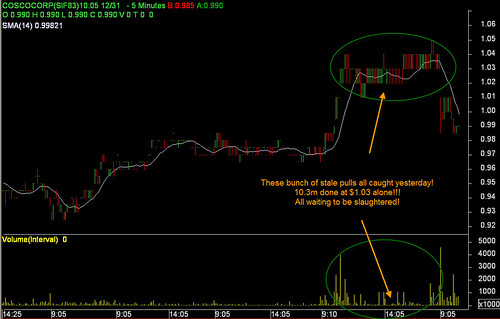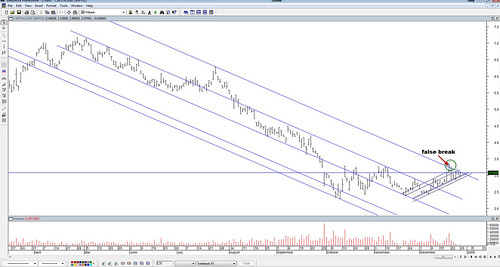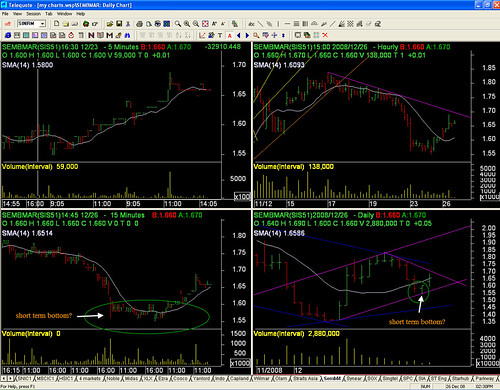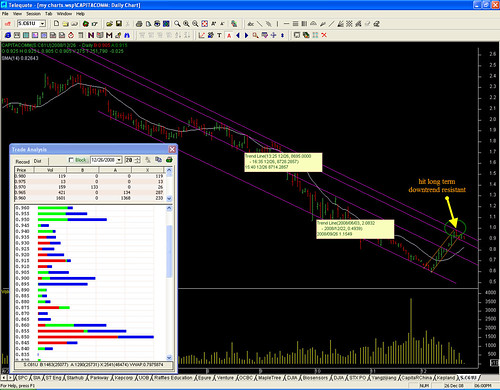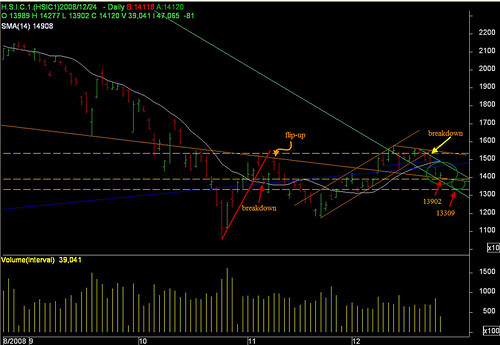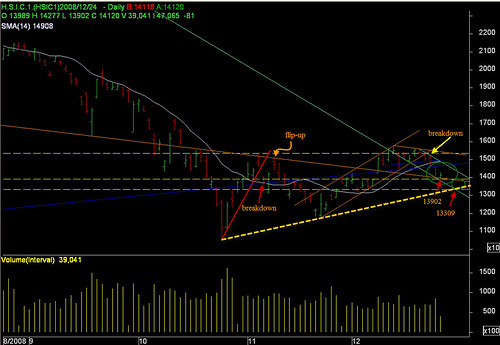ALLCO COMMERCIAL REIT, csfb downgrade to UNDERPERFORM with target price
$0.78($1.00)
- ALLC has attempted and failed to prevent a Moody.s downgrade of its
corporate credit rating from Ba1 to Ba2. Moody.s is currently keeping
ALLC.s rating under review, which could mean a further possible downgrade.
- This is negative for ALLC, as it could imply a potential refinancing
cost. In the event that ALLC cannot get full refinancing, we believe ALLC.s
potential sale of its A$483 (~S$617) worth of AU assets could also end up
in a fire sale, as potential acquirers may take advantage of the situation
or find difficulty in funding. Our analysis suggests a significant dilution
of to our TP and DPU in a fire sale scenario.
- ALLC has outperformed since last Nov. At this level, we see more
potential downside risk given the uncertain outlook. We have raised our
refinancing costs to 4.5% accordingly, and in turn revised our TP to S$0.78
and downgrade the stock to an UNDERPERFORM. On the back of the cut, our 08
DPU has decreased from 9.17 Scts to 7.10 Scts. ALLC is currently trading at
0.49 P/B, and 9.9% yield.
ASCENDAS REITS, daiwa upgrade to BUY with target price $2.75
- Investment case: Largest industrial-property S-REIT and arguably one of
the most defensive, with a diversified and highquality portfolio and a
highly-disciplined (in our opinion) acquisition strategy. AREIT faces
unique opportunities, such as its ideal position to capture CBD spill-over
demand at its multitenanted properties and an inside track in the
development of several potentially highly DPU-accretive properties at the
Changi Business Park site. The stock market has largely ignored these
positive factors, in our view.
- Asset profile: 100% industrial properties (business and science park,
hi-tech industrial, light industrial, logistics and distribution centres,
and warehouse retail facilities); 100% in Singapore.
- Risk profile/major risk factor: Singapore industrial properties are
better insulated from potential peak property-market risks (residential and
office), though future supply will always be a perennial risk. The only
possible risk we see for AREIT is earnings disappointment from
lower-than-expected contributions from development properties and rental
reversions.
- Daiwa RNG valuation assumptions for target price: A weighted-average
leasehold period of 55 years, an effective cap rate of 5.9% (an un-levered
opportunity cost of capital of 7.9% and an assumed growth rate of 2.0%), a
target debt-to-asset ratio of 40%, and a WACC of 6.1%.
ASCOTT RESIDENCE TRUST, daiwa maintain BUY with target price $1.80
- Investment case: Diversified overseas exposure to the relatively stable
Asian serviced-residence industry with strong long-term growth potential;
an attractive balance of DPU yield (12-month forward yield of 7.6%) and DPU
growth (2008-10 CAGR of 14.3%), based on our forecasts; ART has an
investment-property portfolio target of S$2bn by the end of 2008, but the
manager has clarified that it has no intention of raising new equity in
2008 and can comfortably finance up to S$500m in new acquisitions entirely
with debt, and still keep the leverage ratio below 50%.
- Asset profile: 100% serviced-residence properties, including
rental-housing units across Asia; 27% by portfolio value in Singapore, 26%
in China, 20% in Japan, 11% in Vietnam, 9% in The Philippines, 6% in
Indonesia and 1% in Australia (as at 31 December 2007, a total portfolio
value of S$1.49bn).
- Risk profile/major risk factor: Local market-specific and
property-specific risks could surface from time to time (such as Jakarta
and Shanghai properties in 2007), and the portfolio could be severely
affected if a global crisis chokes off FDI flows to Asia.
- Daiwa RNG valuation assumptions for target price: A weighted-average
leasehold period of 75 years, an effective cap rate of 6.05% (an un-levered
opportunity cost of capital of 8.55% and an assumed growth rate of 2.5%), a
target debt-to-asset ratio of 40%, and a WACC of 6.57%.
ASCOTT RESIDENCE TRUST, jpm downgrade to NEUTRAL with target price $1.28
- We downgrade ART to N from OW with a Dec-08 price target of S$1.28/unit:
Over the past year ART has been one of the beneficiaries of strong demand
for serviced apartments in the region. However, as about 60% of the leases
in the portfolio are of shorter than a one-year stay, we see some
vulnerability in ART's earnings going forward. We downgrade ART to Neutral
as we reduce our previously robust assumptions.
- Calibrate our earnings estimates: We have reduced our RevPAU forecast for
FY08 onwards to reflect a less exuberant outlook for the sector and have
also incorporated in the newly acquired Somerset St George in Perth. Our
FY08E-10E DPU estimates have been reduced by 0%-10%.
- Slower long-term growth expected: With the latest inclusion of Japan
rental housing and increasing exposure towards developed markets like
Australia and Japan, we expect lower growth from the current portfolio.
Coupled with considerably less certainties on the growth outlook in
emerging markets, we reduce our assumption of ART's long-term growth to 1%
(2% previously).
- We reduce our Dec-08 price target to S$1.28/unit, based on our DDM model
using a discount rate of 9.39%, increased from 8.49% previously, as a
result of increasing foreign currency exposures. Key risks to our rating
and price target include an unexpected movement in RevPAR and an
improvement in the trust's long-term growth prospects.
AVAPLAS, dmg downgrade to SELL with target price $0.07
-Topline in 1H08 increased 8.1% toS$34.3m as Avaplas experienced revenue
growth in all of its business segments. While the company did manage to
recover from the red from 1H07, the S$0.02m net profit seen in 1H08 was
actually achieved through a tax write-back of S$0.145m. Avaplas also
announced that it is expecting to incur a loss for FY08. Downgrade to SELL
with target price of S$0.07 based on a 15% discount to the industry average
of 0.6x FY08 P/B.
-Hit by high operating costs. Topline in 1H08 increased 8.1% to S$34.3m as
Avaplas experienced revenue growth in all of its business segments. SG&A,
however, served as a drag attributed to the expansion of the company's
operations in Malaysia while higher oil prices which resulted in higher
energy costs was also a factor. While the company did manage to recover
from the red from 1H07, the S$0.02m net profit seen in 1H08 was actually
achieved through a tax write-back of S$0.145m.
-Higher gearing. Balance sheet of Avaplas is looking stretched with net
gearing deteriorating slightly from 11.5% in FY07 to 14.9% in 1H08. The
company also continued to experience negative operating cashflows, as with
the case during 1H07. Going forward, we expect its balance sheet to remain
strained in 2H08.
-Unfavourable near-term outlook. The dismal performance by Avaplas in 1H08
was due mainly to the declining US dollar and the lower-than-expected
demand from its China operations. It was also announced that the expected
loss in FY08 would be further impacted by a one-time charge relating to the
relocation of its Singapore operations to overseas. We expect this one-off
charge to be in the range of S$0.4 – 0.5m.
CAMBRIDGE INDUSTRIAL TRUST, daiwa maintain OUTPERFORM with target price
$0.80
- Investment case: Niche acquisition-growth strategy leveraging on the
manager's independence; 12-month forward yield of 11.9% (based on Daiwa
forecasts) is one of the highest in the sector. Long average lease terms
(6.7 years) and security deposits (16.5 months) are well above the industry
average. We believe CREIT can ride out 2008 without further EFR, with
enough capacity to fund comfortably about S$350m of acquisitions with debt.
- Asset profile: 100% industrial properties (logistics and warehousing,
light industrial, industrial and warehouse, industrial, self storage, and
car showrooms); 100% in Singapore.
- Risk profile/major risk factor: Even though we are comfortable with
low-cost debt funding of acquisitions for the rest of the year, future
acquisitions might not be accretive for CREIT if the unit price languishes
and its cost of equity remains sky high.
- Daiwa RNG valuation assumptions for target price: A weighted average
leasehold period of 45 years, an effective cap rate of 8.1% (an un-levered
opportunity cost of capital of 9.6% and an assumed growth rate of 1.5%), a
target debt-to-asset ratio of 45%, and a WACC of 6.86%.
CAPITACOMMERCIAL TRUST, daiwa upgrade to BUY with target price $2.70
- Investment case: Exposure to a portfolio of arguably the highest quality
office-property assets in the sector; riding the momentum of positive
rental reversions, CCT's FY08-10 DPU growth of 23.3% (based on our
estimates) is the fastest among the SREITs. We believe CCT's
office-portfolio valuation, and hence NAV, is the most conservatively
valued among its peers, at a cap rate (using our FY09 NPI estimate for
net-operating income) of 4.9% (versus 4.2% for the other office S-REITs,
and 4.0% for Singapore office properties).
- Asset profile: Predominant exposure to Singapore (98.6%, with the
remainder in Malaysia through a 30% stake in Quill Capita Trust and
Malaysia Commercial Development Fund) and the office-property (including
two car-park properties) segment with an estimated 77% exposure, with the
remainder in the non-office (retail-mall, convention and hotel) segments of
Raffles City.
- Risk profile/major risk factor: The Singapore office-property sector has
already exceeded its all-time highs in terms of both rentals and capital
values, with new office supply to remain tight up to at least 2010; we
expect at least two more years of robust rental reversions, but the
supply-demand dynamics in four years is still unclear.
- Daiwa RNG valuation assumptions for target price: A weighted-average
leasehold period of 99 years, an effective cap rate of 5.5%, a target
debt-to-asset ratio of 30%, and a WACC of 6.1%.
CAPITACOMMERCIAL TRUST, jpm upgrade to OVERWEIGHT with target price $2.27
- Upgrading CCT to Overweight: We are upgrading our rating on
CapitaCommercial Trust (CCT) to Overweight (previously Neutral) with the
stock having fallen to what we consider to be attractive floor valuations.
The stock has underperformed the FTSE ST REIT Index by 5.4% over the last
year, and underperformed the FTSE ST Index by 39% over the same period.
- CCT's characteristics fit the bill for a REIT investment today: CCT's
income stream is very low risk, supported by a highquality portfolio of
generally under-rented office properties in Singapore's CBD. Gearing is low
at just 24.4%, while the trust has no short-term debt refinancing issues.
- Alleviation of the sectoral short-term debt refinancing overhang could
lead to a re-rating of this stock: CCT's stock has been held back, in our
view, because of the market's worries of the substantial S$3.37 billion
short-term debt refinancing requirements for the S-REIT sector as a whole.
Alleviation of these debt re-financing concerns could reduce CCT's risk
premium and refocus the market's attention on the stock's attractive
fundamentals and reward-risk payoff.
- Our end-Dec-08 target price of S$2.27/unit is based on DDM (up from
S$1.97 previously). We expect CCT to deliver a total return of 20% through
end-Dec-08. Key risks to our price target are an unexpected increase in cap
rates beyond the levels we have already assumed, or a reduction in
equilibrium office rents in Singapore below the S$10psf pm mark, which we
believe is a sustainable through-the-cycle base.
CAPITACOMMERCIAL TRUST, uob maintain BUY with target price $2.45($3.04)
-CapitaCommercial Trust (CCT) invests in income-producing real estate used
for commercial purposes. It owns nine properties in Singapore with 2.3m sf
of office space, which accounts for 7% of private office stock within
Downtown Core. CCT has a 30% stake in Quill Capita Trust (QCT), a
commercial REIT listed on Bursa Malaysia. It has a 7.4% stake in Malaysia
Commercial Development Fund (MCDF), the largest private real estate fund in
Malaysia focusing on investments in Kuala Lumpur and the Klang Valley. CCT
was assigned a corporate rating of A3 with stable outlook by Moody's
Investors Services.
-Huge room for rental reversions. Rentals for prime office space within
Raffles Place and Marina Bay area has shot up from S$8.60 in 1Q07 to
S$15.00psf pm in 4Q07, a result of a supply crunch coupled with strong
demand from financial institutions and oil & gas companies. Rental for
Grade A office space was even higher at S$17.15psf pm in 4Q07. According to
CB Richard Ellis, rentals for Grade A office space could average S$18.50psf
pm by end-08, a further increase of 7.9%. CCT is well positioned to benefit
from positive rental reversion as 56.9% of its leases for office space are
up for renewal in 2008 and 2009, when supply coming onstream is fairly
limited. Some 54% of office space at 6 Battery Road are up for renewal in
2008 and 2009. We understand that in Jan 08, Standard Chartered has renewed
leases for 130,000sf at an average of S$14.95psf pm for three years vs the
previous rate of S$7.00psf pm. About 53% of office space are up for renewal
in 2008 at Robinson Point with existing rent of only S$4.00psf pm. Another
53% of office space are up for renewal in 2009 at Raffles City Tower with
existing rent of only S$3.40psf pm. Positive rental reversion from these
prime office buildings provides revenue growth of 14.8% in FY08 and 12.4%
FY09.
-Redevelopment for Market Street Car Park. CCT has secured Outline Planning
Permission for the redevelopment of Market Street Car Park into a premium
Grade A office tower with estimated net lettable area (NLA) of 680,000sf.
Management estimated the development cost at S$1b-1.5b, depending on the
amount of development premium imposed. Construction is likely to commence
in late-08/early-09 and completion by 1H12. The project is likely to be
undertaken by a JV with an option for CCT to repurchase at a later stage
when rentals have stabilised. Sponsor CapitaLand is the most likely JV
partner. We believe a 50:50 JV is possible, particularly if the project is
developed in phases.
-No risk from refinancing. CCT's current gearing is a low 24% in Dec 07.
The company issued S$150m 3-year medium term note with attractive fixed
interest rate of 3.05% in Mar 08. This has largely satisfied its funding
requirements for refinancing short-term borrowings and the acquisition of
Wilkie Edge, a mixed development project at Selegie Road. CCT plans to
expand its asset size from the current S$5.3b to S$6b by 2009. Potential
pipeline of acquisitions from sponsor CapitaLand includes One George Street
with NLA of 448,000sf and a possible re-development of Golden Shoe Car
Park. CCT provides FY08 distribution yield of 5.12%, a healthy spread of
3.04% over 10-year Singapore government bond yield at 2.08%.
CAPITAMALL TRUST, daiwa maintain BUY with target price $3.61
- Investment case: Multiple DPU-growth drivers, including asset
enhancement, active leasing, acquisitions, and property redevelopment
(Funan DigitaLife Mall with significant office development potential);
proven ability to increase DPU even on enlarged equity base; the largest
S-REIT and best proxy for the sector; asset-size target of S$8bn by 2010;
clear and high-profile acquisition pipeline from sponsor. Moreover, we do
not expect the major DPU drivers to diminish, even if 2008 turns out to be
a challenging year for property landlords and retailers.
- Asset profile: Predominantly in Singapore (98%, with the remainder in
China through a 20% stake in sister S-REIT, CRCT) with retail-mall exposure
(estimated at 90.2%, with the remainder in the non-retail (office,
convention, and hotel) segments of Raffles City, in which it has a 40%
stake).
- Risk profile/major risk factor: New Singapore retail-property supply
(roughly one-third of existing stock over the next four years) creates some
uncertainty. Quality and strong fundamentals do not come cheap, as CMT
trades at the highest premium (P/NAV) in the sector. In times of
indiscriminate heavy market selling, CMT, by far the most liquid S-REIT,
could underperform, in our view.
- Daiwa RNG valuation assumptions for target price: A weighted average
leasehold period of 97 years, an effective cap rate of 5.5%, a target
debt-to-asset ratio of 40%, and a WACC of 6.2 %.
CAPITARETAIL CHINA TRUST, daiwa maintain HOLD with target price $1.43
- Investment case: Exposure to a rapidly expanding portfolio of eight
shopping malls in China; ambitious and assured pipeline of about 70 malls
from sponsor; high DPU-growth outlook (Daiwa forecast's a three-year CAGR
of 22.7%) from accretive acquisitions and asset-enhancement activities.
- Asset profile: Focused solely on shopping malls (100%) throughout China
(100%).
- Risk profile/major risk factor: CRCT faces country, city and
property-specific risks; foreign business culture presents a unique
challenge for the sponsor, a blue-chip Singapore-listed company and paragon
of corporate governance; significant operating inefficiencies for those
malls not developed by the sponsor, creating opportunities for improvement.
With some difficulty (we believe) in raising equity for its maiden Xizhimen
Mall acquisition in Beijing, one of the most attractive assets in its
portfolio, future EFR could be even more challenging if market conditions
and investor appetites remain weak.
- Daiwa RNG valuation assumptions for target price: A weighted-average
leasehold period of 35 years, an effective cap rate of 5.0% (un-levered
opportunity cost of capital of 10.0% and an assumed growth rate of 5.0%), a
target debt-to-asset ratio of 35%, and a WACC of 7.55%.
CDL HOSPITALITY TRUSTS, jpm downgrade to UNDERWEIGHT with target price
$1.51
- We downgrade CDREIT to UW from OW: CDREIT has outperformed JPMorgan's
S-REITs index by 5% over the last six months on the back of robust RevPAR
growth and strong operating leverage. Given the REIT's low visibility on
top-line growth and the significant vulnerability to reduced demand for
business and leisure travel, we downgrade CDREIT to Underweight (previously
Overweight).
- We reduce our FY08-FY10 estimates by about 15%-35%, as we have lowered
our occupancy rate assumptions to 80% and flattening our assumed growth in
room rates for FY09 and FY10. Given the operating leverage, we estimate
that every 10% drop in RevPAR reduces CDREIT's DPU by about 15%.
- Valuation highly sensitive to changes in RevPAR: CDREIT's valuation is
highly sensitive towards changes in RevPAR as a result of operating
leverage. We estimate that every 10% drop in RevPAR assumption could reduce
our valuation by at least 16%.
- We set our Dec-08 price target at S$1.51/unit, based on our DDM. The key
risks to our rating and price target mainly stem from an unexpected
improvement in the RevPAR trend beyond our lowered assumptions and the
inherent difficulty in calculating the effects of operating leverage on the
REIT's distributions at a time of significant volatility in revenues and
expenses.
CHINA XLX, cimb downgrade to NEUTRAL with target price $0.57($1.20)
- Rising coal prices. Anthracite coal prices in China have surged 9% qoq in
1Q08, in part due to disruptions in transportation and shutdowns of smaller
mines during recent snow storms. We expect the tight supply to ease as
operations resume. Conservatively, we have assumed firm coal prices of
Rmb900/tonne for FY08-10.
- 1Q08 urea gross margins expected at 29% (-1.6% pts qoq). According to our
sensitivity analysis, every Rmb50/tonne increase in anthracite coal prices
could reduce CXLX's urea gross margins by 2% pts, while a corresponding
Rmb50/tonne increase in urea selling prices could increase its gross
margins by 2% pts.
- Potential increase in urea price ceiling in 2H08. We think that China's
price ceiling for urea will inevitably be raised, as the wide disparity
between international and domestic prices could more than offset higher
export taxes. However, we do not think the price increase would start in
the coming quarter due to sufficient urea inventories and the
reconstruction of snowstorm-hit farming areas.
- FY08-10 EPS forecasts cut by 15-39%, to account for higher coal and raw
material prices, a higher effective tax rate and lower compound fertiliser
ASP assumptions. We have not factored in potential increases in the urea
price ceiling.
- Downgrade from Outperform to Neutral; target price reduced to S$0.57 from
S$1.20. We have used a lower P/E target of 10x on CY09 earnings (12x
previously). This represents a larger discount to Hong Kong-listed peers
than previously, in view of CXLX's limited urea export exposure compared to
China BlueChemical (3983 HK) and CXLX's less diversified portfolio compared
to Sinofert Holdings (0297 HK).
CSC HOLDINGS, dbs initial coverage HOLD with target price $0.29
-CSC is a leading foundation and geotechnical engineering specialist in
Singapore with a large fleet size of c. 209 rigs and offers a complete
range of piling solutions.
-Acquisition growth strategy positive…. CSC has cemented its leading market
position through its acquisition strategy. The company has proven its
capabilities to pick earnings accretive acquisitions of between 5-10X PER.
Recent acquisitions of Wisescan and JV with IJM should contribute S$2.9m to
the Group's bottomline in FY09 and S$4.8m in FY10.
-… but CSC is unlikely to repeat record order wins of S$488m in FY08, order
wins to slow to S$300m pa in FY09 and FY10. CSC has a healthy order book of
S$435m (3.4x FY07 revenue) as of March 2008. Given the bullish outlook for
construction sector in 2008, driven by firm demand from both private and
public sectors, we expect CSC to achieve contract wins of S$300m in FY09
and FY10 each year. Projects such as the Sports Hub and Tuas' petrochemical
plants coming onstream will support its contract wins. However, CSC is
unlikely to exceed $488m contract wins attained in FY08, which was largely
attributed to the $190m Marina Sands contract.
-Expect decline in gross margins and net profit. We have assumed gross
margin compression from rising steel and RMC prices, which currently
account for c. 50% of CSC's COGS. Steel prices, which rose 23% since Dec
07, are expected to increase by a further 20% in 2Q08. RMC prices are
expected to rise in tandem with a 35% increase in demand in 2008. As such,
we have forecasted lower gross margins of 19.5% for FY09 versus HY08's
22.3%. Consequently, we expect net profit to decline 6% yoy from $41m to
$39m in FY09.
-CSC share price surged 25% to its peak of S$0.47 in July 07 sparked by the
announcement of its prized Marina Sands contracts in May-July 07. Since
then, share price has corrected to a 3-month average of S$0.28 despite new
contract wins in Jan 08. The share currently trades at a PE of 7.2x and
7.1x on FY09 and FY10 earnings respectively, compared to 8.4x for its peers
in the construction industry. Given its niche as a foundation specialist,
we believe it is fair to apply 9x PE on its FY09 earnings, which translates
to S$0.29, representing an upside of 14%. We are thus initiating coverage
on CSC with a HOLD rating.
-Re-rating opportunities could arise when (i) the proposed acquisition of a
60% stake in CLS Holdings, which specializes in earth excavation works, is
concluded; could add S$7.3m to CSC's PBT in FY09 and FY10 each year. (ii)
CSC announces more sizable contract wins, which could raise our contract
wins assumptions.
CSE GLOBAL, bnp maintain BUY with target price $1.57
-Oil and gas plays sold down on raw-materials fear. In recent weeks, almost
all oil-and-gas-related plays have been sold down heavily and have
underperformed the STI (Exhibit 1). We believe this may be due to fears of
rising steel costs (Exhibit 2), which are up about 30% y-y this year. CSE
was also not spared, with its share price correcting 16.0% to SGD0.84 in
just a matter of two weeks.
-CSE has minimal exposure to rising steel costs. During our recent visit to
CSE's premises in Singapore, we saw the assembly of some control and
telecom systems (Exhibits 4 and 5). The key component of these systems is
the microprocessor, which the group procures from third-party suppliers.
CSE has very minimal steel requirements, which are only in the form of
steel racks and cabinets. We understand from management that steel
constitutes less than 1% of its COGS. Furthermore, the group uses mainly
stainless steel, which has been on a downward trend due to the collapse of
the price of nickel (Exhibit 3). In addition, CSE procures the necessary
equipment only when it has gotten a firm order, which implies very low
inventory risk. This can be seen from the group's inventory of only SGD9.0m
as of end 2007.
-Order flow stays solid, 2008 earnings in the bag. We understand from
management that the group has racked up some SGD90m worth of new orders so
far and remains on track for orders of SGD120m-130m in 1Q08. Management
expects new orders for the full year to hit some SGD500m, an increase of
about 15.0% y-y. We believe there is a high level of certainty for 2008
earnings given the continued solid oil and gas flow and contribution from
government initiatives (UK health care, Singapore ERP), which should be
recession proof. As shown in Exhibit 6, our analysis of CSE's order backlog
suggests that the group should achieve revenue of SGD460m this year even
without any more new orders. This already constitutes 88.0% of our
forecast.
-Maintain BUY; TP of SGD1.57, based on 14x 2008E EPS. Our TP stays at
SGD1.57 based on 14x 2008E EPS. We deem this appropriate given a three-year
EPS CAGR of 26.3%, or PEG of 0.53x. The 2008 dividend yield is now an
attractive 4.8%. BUY.
FRASERS CENTREPOINT, daiwa maintain OUTPERFORM with target price $1.54
- Investment case: The only S-REIT with pure exposure to the defensive
suburban shopping-mall segment; visible, long-term acquisition pipeline of
Singapore suburban malls from its sponsor; positive rental reversions on
existing portfolio as 32.8% of leases (by gross rental income) are up for
renewal for FY08 and 30.5% for FY09.
- Asset profile: 100% retail malls predominantly in Singapore (95.5%, with
the remainder in its 27% stake in Hektar REIT (HEKT MK, RM1.40, Not rated),
a complementary suburbanmall REIT in Malaysia).
- Risk profile/major risk factor: We see limited risk from its mall
properties. However, FCT's balance sheet strength and capacity to finance
the Northpoint 2 acquisition (and possibly even the Yew Tee Point
acquisition) entirely with debt implies that its limited free float and
liquidity is likely to persist for some time, in our view.
- Daiwa RNG valuation assumptions for target price: A weighted-average
leasehold period of 88 years, effective cap rate of 5.75% (an un-levered
opportunity cost of capital of 8.25% and an assumed growth rate of 2.5%),
target debt-to-asset ratio of 35%, and WACC of 6.66%.
K-REIT, daiwa maintain BUY with target price $1.64
- Investment case: Small office-property S-REIT riding the positive
rental-reversion cycle and scaling up big through the acquisition of a
one-third stake in ORQ from its sponsor. The release of its proposed
rights-issue circular, dated 13 March 2008, suggested only modest dilution
from the impending rights issue, and not as severe as our earlier
expectations. We estimate attractive adjusted (ex-rights) yields of 8.2%
for 2009 and 9.7% for 2010. We estimate upside potential of 27.6% to our
target price on a theoretical ex-rights basis.
- Asset profile: Pure exposure to office properties (100%) and Singapore
(100%).
- Risk profile/major risk factor: KREIT's fortunes are highly dependent on
the Singapore office market, which we believe still looks positive, given
the tight supply situation and several more years of robust rental
reversions. The rights issue might alienate minority unitholders (and deter
investors from future EFRs) with its dilution, and might not improve free
float or liquidity if the sponsor ends up mopping up most of the new rights
units.
- Daiwa RNG valuation assumptions for target price: A weighted-average
leasehold period of 150 years, an effective cap rate of 3.65% (an
un-levered opportunity cost of capital of 5.15%, and an assumed growth rate
of 1.5%), a target debt-toassets ratio of 27%, and a WACC of 4.84%.
KEPPEL LAND, cl downgrade to UNDERPERFORM with target price $5.63
-We are downgrading Keppel Land from BUY to an Underperform with a revised
target price of S$5.63. We do not believe the tightening credit situation
will ease by 1H08 and more likely to worsen going into 2009. Our aggressive
cuts to assumptions on residential ASPs across key markets in Singapore and
China and a further delay of six to twelve months for upcoming projects has
led us to cut earnings for FY08 by 12%. Our target price of S$5.63 is
pegged to parity on forward FY09 RNAV.
-Bearish assumptions. Our aggressive downgrade in assumptions of fair spot
rents for Prime Grade A from S$15psf to S$12psf for FY08 and FY09 and a cap
rate expansion for commercial assets in 2009 is the reason for the massive
drop in FY09 RNAV. On the domestic residential segment, we have applied a
more bearish assumption of 10% to 15% decline in ASP from the already
negative outlook in mid high end and luxury segments. Similarly, in line
with our China property team, we have cut our china residential ASPs from
the previous 25% price increase to 8%. Apart from lowered ASP assumptions,
we have also factored in delay in residential launches and a lower target
price for listed entity K-Reit. We have bumped up our cap rate assumption
by 100bps to 6% in FY09 to reflect the increasing risk aversion stemming
from the external credit market crisis as well as the impending
supplycoming on stream in 2009. Over the past year in the office market
average
prime office yields have inched up since hitting a low of 4.1% in 2Q07 and
we believe it is not far from the two historical peaks at closer to 6%.
-Downgrade to Underperform. The downgrade shaved off earnings for FY08 by
12% and we have rolled forward our target price by pegging at parity to
FY09 RNAV of S$5.63 with an UPF recommendation from the previous BUY.
